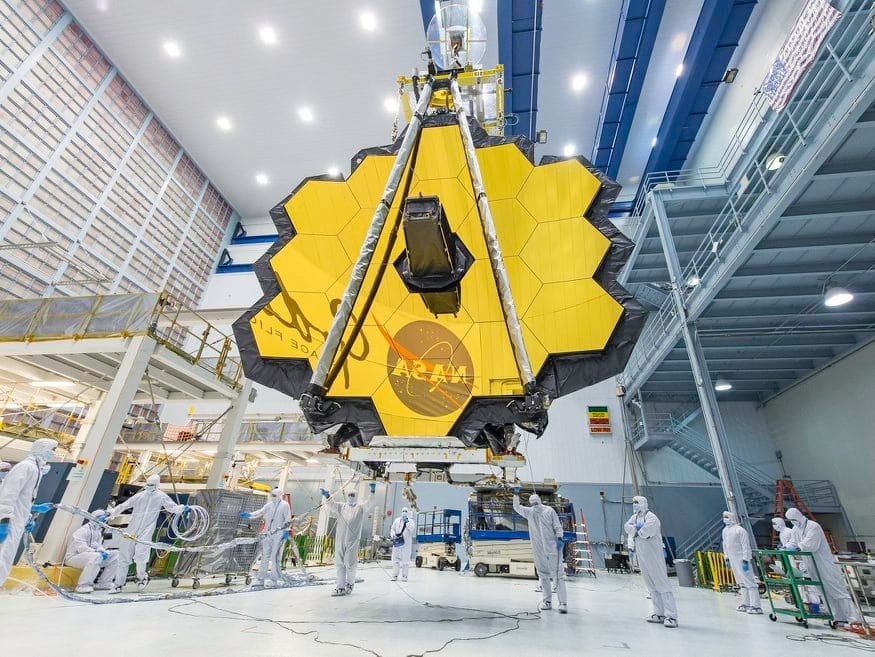Every February, to help celebrate Darwin Day, the Science section of AIPT cranks up the critical thinking for SKEPTICISM MONTH! Skepticism is an approach to evaluating claims that emphasizes evidence and applies the tools of science. All month we’ll be highlighting skepticism in pop culture, and skepticism *OF* pop culture.
Today, we look at the amazing things the James Webb Space Telescope can do, while pointing out what it’s NOT designed for.
The James Webb Space Telescope (JWST) is a marvel of modern science and technology. Conceived in the 1990s with an original launch date of 2007, the world waited 14 more years to finally see this incredible piece of engineering launched on Christmas Day, 2021.
This international collaboration between NASA, the European Space Agency (ESA), and the Canadian Space Agency (CSA) is now orbiting the Sun at Earth’s L2 Lagrange point, a position 1,500,000 km away, where the combined gravitational pulls of the Earth and the Sun allow a small mass to move with the system. The L2 point in particular is ideal, due to its proximity to Earth and the ability to keep a clear view of deep space.

Image credit: Northrop Grumman
Considered the successor to the Hubble and Spitzer space telescopes, the JWST will use infrared astronomy to peer through the gas and dust throughout interstellar space to see older, dimmer, cooler objects than its predecessors could. As our universe expands, the light waves traveling through it stretch, becoming more easily detected in the infrared. With a 6.5 meter, 18-piece gold mirror, the expectation is that the JWST will see deep enough into space to detect stars and galaxies which formed in the first few hundred million years after the Big Bang.
Scientists will then be able to gain information on how galaxies form and evolve. The ability to see infrared light through gas and dust will also allow the JWST to get a better view of brown dwarfs, comets, and exoplanets, gathering data on star and planetary formation throughout the universe, as well as the development of our own solar system.
While the idea of seeing the first stars and galaxies to ever form is exciting to the astronomical community, many in the public are more interested in whether the JWST will find aliens on the distant planets it studies. With the recent release of the Pentagon UFO Report and video footage of Unidentified Aerial Phenomenon (UAP), people are hoping for confirmation of intelligent life beyond our planet.
Some want that confirmation in the form of a photograph of a definitive alien structure, and they look for it everywhere. Most recently a man named Scott C. Waring claimed to have found an alien lying down and watching the Mars Rover, in images from the rover itself. Much like the supposed face on Mars, it’s just an optical illusion and pareidolia, the human tendency to see faces in shadows or arbitrarily arranged objects. There are some who are so convinced the JWST will be able to actually see extraterrestrial civilizations, they even believe there were dozens of alien spacecraft in orbit around the Earth, observing the launch. They might be disappointed by the actual data.
Infrared astronomy allows for some amazing things, but it won’t let us peer down on the surfaces of planets in other solar systems, and certainly not in other galaxies. The JWST will be able to take measurements from the surfaces of Titan, Europa, and Enceladus, but if there were intelligent life to be found on those moons, or other objects in our own solar system that we could see with a telescope, we’d have seen it by now.
So what will the JWST look for that could indicate life on another planet? Using infrared light enables the detection of methane, carbon dioxide, and water molecules (which are all possible indicators of life) in the atmospheres of possible Earth-like planets. One system that will be studied early on the mission will be the TRAPPIST-1 system, which is only 39 light years away and is orbited by seven Earth-sized, rocky planets in the so-called habitable zone of a red dwarf star. With some of the planets in the system possibly containing more water than on Earth, NASA believes this is an excellent place to look for the atmospheric signatures that we associate with biological processes.

Artist’s impression of the TRAPPIST-1 system. (Image credit: M. Kornmesser/ESO)
While the data collected by the JWST will tell us if a planet is potentially habitable for humans and/or contains the building blocks of life, that’s by no means the smoking gun that seeing an actual alien city would be. Still, the information does promise to offer great advances in our understanding of planetary atmospheric dynamics.
Since the days when Jocelyn Bell Burnell first captured a repeating signal on an early radio telescope which was labeled “LGM,” in the hope it was a signal from Little Green Men, people have wanted to use advancing telescope technology to find definitive proof of the existence of aliens. Hubble didn’t find it on Europa, Spitzer found alien worlds but no actual aliens, the Vatican doesn’t have an alien-hunting telescope named LUCIFER, and sadly the JWST will not be taking infrared images of alien cities in distant galaxies.
AIPT Science is co-presented by AIPT and the New York City Skeptics.
Join the AIPT Patreon
Want to take our relationship to the next level? Become a patron today to gain access to exclusive perks, such as:
- ❌ Remove all ads on the website
- 💬 Join our Discord community, where we chat about the latest news and releases from everything we cover on AIPT
- 📗 Access to our monthly book club
- 📦 Get a physical trade paperback shipped to you every month
- 💥 And more!














You must be logged in to post a comment.